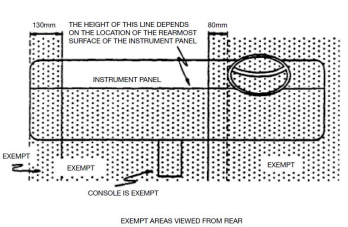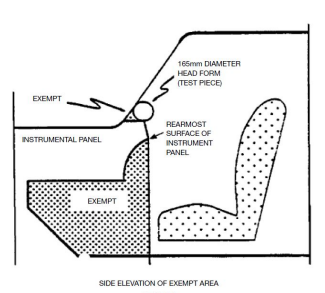This information provides guidance for the choice of impact protection material to be used inside vehicles to protect passengers in the event of a collision.
Modern vehicles, which are designed to meet the requirements of the Australian Design Rules (ADRs), do not normally need additional padding. However, modifications, such as the installation of communications equipment, may mean that passengers will be exposed to hard surfaces that will increase the risk of injury.
Areas to be padded
Padding is required when equipment is installed in the area of the instrument panel within the head impact area.
The head impact area is part of the instrument panel or dashboard that can be contacted by a 165 mm diameter sphere, as shown in figures 1 and 2.
Padding should also be used wherever internal modifications have hard surfaces which are likely to be struck by the head or limbs of seated passengers in the event of a collision or rollover.
The padding must be securely fastened to the structure. Any fastenings used must be protected to ensure that they do not present a source of injury.

Figure 1. Exempt areas viewed
from the rear

Figure 2. Side evaluation of the
exempt area
Note: Vehicles must not be modified in such a way as to interfere with the operation of the airbags - supplementary restraint systems. Later model vehicles may have side-impact airbags in the body or seats, as well as frontal impact airbags in the steering wheel and dashboard.
Tops of seats
In vehicles made on or after 1 January 1995 it is a requirement that the top face and back of any seat that is in front of another seating position is capable of absorbing impact energy.
This means that, if a seat is installed behind an existing seat it may be necessary to fit additional padding. If the top face and the rear face of the seat are not already padded, additional padding is to be fitted to these surfaces. The padding of the rear face of the seat is to extend at least 100 mm down the back of the seat from the top face.
Any fittings on the back of the seat outside the padded area must be of a type that is not likely to cause injury to a passenger during impact.
Performance requirements
These foams work by slowing down the impact of the head or limbs against the interior of the car so that the crash energy is absorbed over as long as time as possible. This is particularly important in the case of the head, to reduce the peak acceleration experienced by the brain.
To do this satisfactorily the foam actually needs to be fairly firm. Motorcycle helmet liners are a good example. It is not the thin lining of open-cell foam rubber that provides protection in a helmet (it is there for comfort and fit). The protection is provided by the much thicker layer of polystyrene foam, which progressively collapses under impact.
Consequently, the acceptable padding materials are those that, when mounted on structures of at least the same stiffness as the structures on which it is to be installed, have been shown to achieve either:
- a headform deceleration of not more than 80 times the acceleration due to gravity for more than 3 milliseconds, when tested according to the requirements of clause 6.4 of ADR 3/02 Seats and Seat Anchorages, or
- a head injury criterion (HIC) of less than 1000, when tested according to the relevant clauses of ADR 68/00 Occupant Protection in Buses.
Both of these tests require impacting the padded structure with a spherical headform, diameter 165mm, and mass 6.8 + 0.1 kg, moving at not less than 6.69 m/s (24 km/h).
Padding materials
The choice of padding material and method of attachment is left to the individual installer, but the materials chosen must be of a standard and thickness that will offer the same level of protection as required above.
The following materials are recommended, as they have been shown to meet the performance requirement, but are not mandatory:
- semi-rigid moulded polyurethane, approximate density 300 kg/m3, 25mm thick
- self-skinning rigid moulded polyurethane, approximate density 300 kg/m3, 25mm thick
- closed-cell polyethylene foam, approximate density 300 kg/m3, 25mm thick
- closed-cell EVA foam, approximate density 300 kg/ m3, 25mm thick.
Expanded polystyrene foam, as is used in crash helmets, has acceptable energy absorption properties and has densities between 50 and 65 kg/m3. It is not suitable for most automotive applications, as it is permanently deformed when impacted, which is why helmets must be discarded after a crash. Slow-rebound foams such as butyl nitrate or expanded polypropylene are suitable.
Foams used for upholstery work, and most foam pipe insulation, are not acceptable for occupant protection padding. This is because they are too soft.
Other materials are available. Flexible cellular materials are frequently specified to ASTM Standard 3575. Suffix D of this standard defines a compression deflection test which reports the pressure in kilopascals to compress by 25% a 25mm thick circular specimen of 2500 mm2 area. Suitable materials for padding would generally have ASTM D3575 compression deflection specifications within the range of 250 to 500 kPa.
Vehicle Standards reference: MR864.

